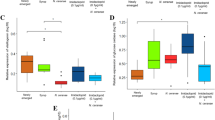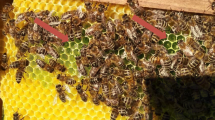Abstract
In recent years, there has been growing concern on the potential weakening of honey bees and their increased susceptibility to pathogens due to chronic exposure to xenobiotics. The present work aimed to study the effects on bees undergoing an infection by Nosema ceranae and being exposed to a frequently used in-hive acaricide, amitraz. To achieve this, newly emerged bees were individually infected with N. ceranae spores and/or received a sublethal concentration of amitraz in their diets under laboratory conditions. Mortality, food intake, total volume excrement, body appearance, and parasite development were registered. Bees exposed to both stressors jointly had higher mortality rates compared to bees exposed separately, with no difference in the parasite development. An increase in sugar syrup consumption was observed for all treated bees while infected bees fed with amitraz also showed a diminishment in pollen intake. These results coupled with an increase in the total number of excretion events, alterations in behavior and body surface on individuals that received amitraz could evidence the detrimental action of this molecule. To corroborate these findings under semi-field conditions, worker bees were artificially infected, marked, and released into colonies. Then, they were exposed to a commercial amitraz-based product by contact. The recovered bees showed no differences in the parasite development due to amitraz exposure. This study provides evidence to which extent a honey bee infected with N. ceranae could potentially be weakened by chronic exposure to amitraz treatment.







Similar content being viewed by others
Data availability
Datasets used can be required to corresponding author.
References
Alaux C, Brunet JL, Dussaubat C, Mondet F, Tchamitchan S, Cousin M, Brillard J, Baldy A, Belzunces LP, Le Conte Y (2010) Interactions between Nosema microspores and a neonicotinoid weaken honeybees (Apis mellifera). Environ Microbiol 12(3):774–782. https://doi.org/10.1111/j.1462-2920.2009.02123.x
Aufauvre J, Biron DG, Vidau C, Fontbonne R, Roudel M, Diogon M, Viguès B, Belzunces LP, Delbac F, Blot N (2012) Parasite-insecticide interactions: a case study of Nosema ceranae and fipronil synergy on honeybee. Sci Rep 2(1):326. https://doi.org/10.1038/srep00326
Bailey L (1967) Nosema apis and dysentery of the honeybee. J Apic Res 6(3):121–125. https://doi.org/10.1080/00218839.1967.11100171
Bailey L (1981) Honey bee pathology. Academic Press, London
Boecking O, Genersch E (2008) Varroosis–the ongoing crisis in bee keeping. J Verbr Lebensm 3:221–228. https://doi.org/10.1007/s00003-008-0331-y
Boi M, Serra G, Colombo R, Lodesani M, Massi S, Costa C (2016) A 10 year survey of acaricide residues in beeswax analysed in Italy. Pest Manag Sci 72(7):1366–1372. https://doi.org/10.1002/ps.4161
Bommuraj V, Chen Y, Birenboim M, Barel S, Shimshoni JA (2021) Concentration-and time-dependent toxicity of commonly encountered pesticides and pesticide mixtures to honeybees (Apis mellifera L.). Chemosphere 266:128974. https://doi.org/10.1016/j.chemosphere.2020.128974
Bordier C, Pioz M, Crauser D, Le Conte Y, Alaux C (2017) Should I stay or should I go: honeybee drifting behaviour as a function of parasitism. Apidologie 48(3):286–297. https://doi.org/10.1007/s13592-016-0475-1
Cantwell GE (1970) Standard methods for counting nosema spores. Am Bee J 110:222–223
Di Pasquale G, Salignon M, Le Conte Y, Belzunces LP, Decourtye A, Kretzschmar A, Suchail S, Brunet J-L, Alaux C (2013) Influence of pollen nutrition on honey bee health: do pollen quality and diversity matter? PloS one 8(8):e72016. https://doi.org/10.1371/journal.pone.0072016
Fisher A, Rangel J (2018) Exposure to pesticides during development negatively affects honey bee (Apis mellifera) drone sperm viability. PLoS ONE 13(12):e0208630. https://doi.org/10.1371/journal.pone.0208630
Floris I, Satta A, Garau VL, Melis M, Cabras P, Aloul N (2001) Effectiveness, persistence, and residue of amitraz plastic strips in the apiary control of Varroa destructor. Apidologie 32(6):577–585. https://doi.org/10.1051/apido:2001145
García-Palencia P, Martín-Hernández R, González-Porto AV, Marin P, Meana A, Higes M (2010) Natural infection by Nosema ceranae causes similar lesions as in experimentally infected caged-worker honey bees (Apis mellifera). J Apic Res 49(3):278–283. https://doi.org/10.3896/IBRA.1.49.3.08
Garrido PM, Porrini MP, Antúnez K, Branchiccela B, Martínez-Noël GMA, Zunino P, Salerno G, Javier EM, Ieno E (2016) Sublethal effects of acaricides and Nosema ceranae infection on immune related gene expression in honeybees. Vet Res 47:1–9. https://doi.org/10.1186/s13567-016-0335-z
Garrido PM, Porrini MP, Alberoni D, Baffoni L, Scott D, Mifsud D, Eguaras MJ, Di Gioia, D (2023) Beneficial bacteria and plant extracts promote honey bee health and reduce nosema ceranae infection. Probiotics and Antimicrob Proteins, 1-16. https://doi.org/10.1007/s12602-022-10025-7
Gashout HA, Guzman-Novoa E, Goodwin PH (2020) Synthetic and natural acaricides impair hygienic and foraging behaviors of honey bees. Apidologie 51:1155–1165. https://doi.org/10.1007/s13592-020-00793-y
Gregorc A, Bowen ID (2000) Histochemical characterization of cell death in honeybee larvae midgut after treatment with Paenibacillus larvae, amitraz and oxytetracycline. Cell Biol Int 24(5):319–324. https://doi.org/10.1006/cbir.1999.0490
Higes M, García-Palencia P, Martín-Hernández R, Meana A (2007) Experimental infection of Apis mellifera honeybees with Nosema ceranae (Microsporidia). J Invertebr Pathol 94(3):211–217. https://doi.org/10.1016/j.jip.2006.11.001
Higes M, Martín-Hernández R, Botías C, Bailón EG, González-Porto AV, Barrios L, del Nozal MJ, Bernal JL, Jiménez JJ, García-Palencia P, Meana A (2008) How natural infection by Nosema ceranae causes honeybee colony collapse. Environ Microbiol 10(10):2659–2669. https://doi.org/10.1111/j.1462-2920.2008.01687.x
Hillier NK, Frost EH, Shutler D (2013) Fate of dermally applied miticides fluvalinate and amitraz within honey bee (Hymenoptera: Apidae) bodies. J Econ Entomol 106(2):558–565. https://doi.org/10.1603/EC12300
Jack CJ, Uppala SS, Lucas HM, Sagili RR (2016) Effects of pollen dilution on infection of Nosema ceranae in honey bees. J Insect Physiol 87:12–19. https://doi.org/10.1016/j.jinsphys.2016.01.004
Korta E, Bakkali A, Berrueta LA, Gallo B, Vicente F, Kilchenmann V, Bogdanov S (2001) Study of acaricide stability in honey. characterization of amitraz degradation products in honey and beeswax. J Agric food Chem 49(12):5835–5842. https://doi.org/10.1021/jf010787s
Korta E, Bakkali A, Berrueta LA, Gallo B, Vicente F, Bogdanov S (2003) Determination of amitraz and other acaricide residues in beeswax. Anal Chim Acta 475(1–2):97–103. https://doi.org/10.1016/S0003-2670(02)01221-7
Kralj J, Fuchs S (2010) Nosema sp. wirkt sich auf das Flugverhalten infizierter Sammlerinnen von Honigbienen (Apis mellifera) aus. Apidologie 41:21–28. https://doi.org/10.1051/apido/2009046
Maggi MD, Ruffinengo SR, Gende LB, Eguaras MJ, Sardella NH (2008) LC50 baseline levels of amitraz, coumaphos, fluvalinate and flumethrin in populations of Varroa destructor from Buenos Aires Province. Argent J Apic Res 47(4):292–295. https://doi.org/10.1080/00218839.2008.11101477
Martín-Hernández R, Bartolomé C, Chejanovsky N, Le Conte Y, Dalmon A, Dussaubat C, García-Palencia P, Meana A, Pinto MA, Soroker V, Higes M (2018) Nosema ceranae in Apis mellifera: a 12 years postdetection perspective. Environ Microbiol 20(4):1302–1329. https://doi.org/10.1111/1462-2920.14103
Mayack C, Naug D (2009) Energetic stress in the honeybee Apis mellifera from Nosema ceranae infection. J Invertebr Pathol 100(3):185–188. https://doi.org/10.1016/j.jip.2008.12.001
Mayack C, Naug D (2010) Parasitic infection leads to decline in hemolymph sugar levels in honeybee foragers. J Insect Physiol 56(11):1572–1575. https://doi.org/10.1016/j.jinsphys.2010.05.016
Mullin CA, Frazier M, Frazier JL, Ashcraft S, Simonds R, VanEngelsdorp D, Pettis JS (2010) High levels of miticides and agrochemicals in North American apiaries: implications for honey bee health. PLoS ONE 5(3):e9754. https://doi.org/10.1371/journal.pone.0009754
Murcia-Morales M, Díaz-Galiano FJ, Vejsnæs F, Kilpinen O, Van der Steen JJ, Fernández-Alba AR (2021) Environmental monitoring study of pesticide contamination in Denmark through honey bee colonies using APIStrip-based sampling. Environ Pollut 290:117888. https://doi.org/10.1016/j.envpol.2021.117888
Nguyen BK, Saegerman C, Pirard C, Mignon J, Widart J, Thirionet B, Verheggen FJ, Berkvens D, De Pauw E, Haubruge E (2009) Does imidacloprid seed-treated maize have an impact on honey bee mortality? J Econ Entomol 102(2):616–623. https://doi.org/10.1603/029.102.0220
O’Neal ST, Brewster CC, Bloomquist JR, Anderson TD (2017) Amitraz and its metabolite modulate honey bee cardiac function and tolerance to viral infection. J Invertebr Pathol 149:119–126. https://doi.org/10.1016/j.jip.2017.08.005
O'Neal ST, Anderson TD, Wu-Smart JY (2018) Interactions between pesticides and pathogen susceptibility in honey bees. Curr Opin Insect Sci. 57–62. https://doi.org/10.1016/j.cois.2018.01.006
Papaefthimiou C, Papachristoforou A, Theophilidis G (2013) Biphasic responses of the honeybee heart to nanomolar concentrations of amitraz. Pestic Biochem Physiol 107(1):132–137. https://doi.org/10.1016/j.pestbp.2013.06.005
Papežíková I, Palíková M, Navrátil S, Heumannová R, Fronc M (2016) The effect of oxalic acid applied by sublimation on honey bee colony fitness: a comparison with amitraz. Acta Vet Brno 85(3):255–260. https://doi.org/10.2754/avb201685030255
Pettis JS, Vanengelsdorp D, Johnson J, Dively G (2012) Pesticide exposure in honey bees results in increased levels of the gut pathogen Nosema. Naturwissenschaften 99:153–158. https://doi.org/10.1007/s00114-011-0881-1
Pierpoint AC, Hapeman CJ, Torrents A (1997) Kinetics and mechanism of amitraz hydrolysis. J Agric Food Chem 45(5):1937–1939. https://doi.org/10.1021/jf970049x
Porrini MP, Sarlo EG, Medici SK, Garrido PM, Porrini DP, Damiani N, Eguaras MJ (2011) Nosema ceranae development in Apis mellifera: influence of diet and infective inoculum. J Apic Res 50(1):35–41. https://doi.org/10.3896/IBRA.1.50.1.04
Porrini MP, Garrido PM, Eguaras MJ (2013) Individual feeding of honey bees: modification of the Rinderer technique. J Apic Res 52(5):194–195. https://doi.org/10.3896/IBRA.1.52.5.0
Porrini MP, Garrido PM, Umpiérrez ML, Porrini LP, Cuniolo A, Davyt B, González A, Eguaras MJ, Rossini C (2020) Effects of synthetic acaricides and Nosema ceranae (Microsporidia: Nosematidae) on molecules associated with chemical communication and recognition in honey bees. Vet Sci 7(4):199. https://doi.org/10.3390/vetsci7040199
Retschnig G, Neumann P, Williams GR (2014) Thiacloprid-Nosema ceranae interactions in honey bees: host survivorship but not parasite reproduction is dependent on pesticide dose. J Invertebr Pathol 118:18–19. https://doi.org/10.1016/j.jip.2014.02.008
Rodríguez-Dehaibes SR, Otero-Colina G, Sedas VP, Jiménez JAV (2005) Resistance to amitraz and flumethrin in Varroa destructor populations from Veracruz. Mex J Apic Res 44(3):124–125. https://doi.org/10.1080/00218839.2005.11101162
Rosenkranz P, Aumeier P, Ziegelmann B (2010) Biology and control of Varroa destructor. J Invertebr Pathol 103:S96–S119. https://doi.org/10.1016/j.jip.2009.07.016
Tokarev YS, Huang WF, Solter LF, Malysh JM, Becnel JJ, Vossbrinck CR (2020) A formal redefinition of the genera Nosema and Vairimorpha (Microsporidia: Nosematidae) and reassignment of species based on molecular phylogenetics. J Invertebr Pathol 169:107279. https://doi.org/10.1016/j.jip.2019.107279
Funding
This work was supported by Agencia Nacional de Promoción Científica y Tecnológica, Fondo para la Investigación Científica y Tecnológica, under projects PICT-2017–2169, PICT-2018–3969, and PICT-2021–00120.
Author information
Authors and Affiliations
Contributions
PMG and MPP conceived and designed the study. Material preparation, data collection and analysis were performed by CZ, PMG and MPP. Supervision of the research was driven by PMG and MPP. The funding acquisition was made by PMG, MPP and MJE. The manuscript was written by CZ, PMG and MPP and all authors commented on further versions. All authors read and approved the final manuscript.
Corresponding author
Ethics declarations
Ethical approval
No approval of research ethics committees was required to accomplish the goals of this study because experimental work was conducted with an unregulated invertebrate species.
Consent to participate and publish
All authors read and approved the final manuscript.
Competing interests
The authors declare no competing interests.
Additional information
Handling Editor: Julia Walochnik.
Publisher's Note
Springer Nature remains neutral with regard to jurisdictional claims in published maps and institutional affiliations.
Rights and permissions
Springer Nature or its licensor (e.g. a society or other partner) holds exclusive rights to this article under a publishing agreement with the author(s) or other rightsholder(s); author self-archiving of the accepted manuscript version of this article is solely governed by the terms of such publishing agreement and applicable law.
About this article
Cite this article
Zufriategui, C., Porrini, M.P., Eguaras, M.J. et al. Detrimental effects of amitraz exposure in honey bees (Apis mellifera) infected with Nosema ceranae. Parasitol Res 123, 204 (2024). https://doi.org/10.1007/s00436-024-08225-x
Received:
Accepted:
Published:
DOI: https://doi.org/10.1007/s00436-024-08225-x




